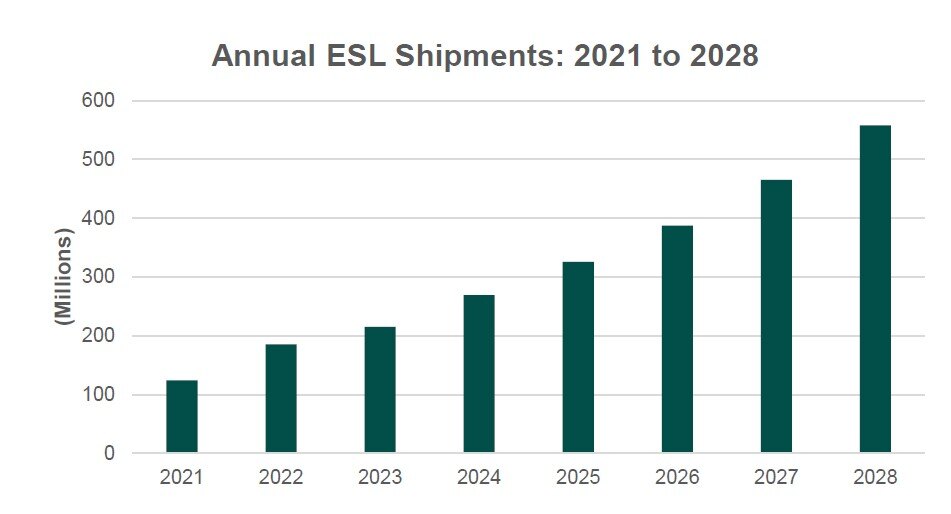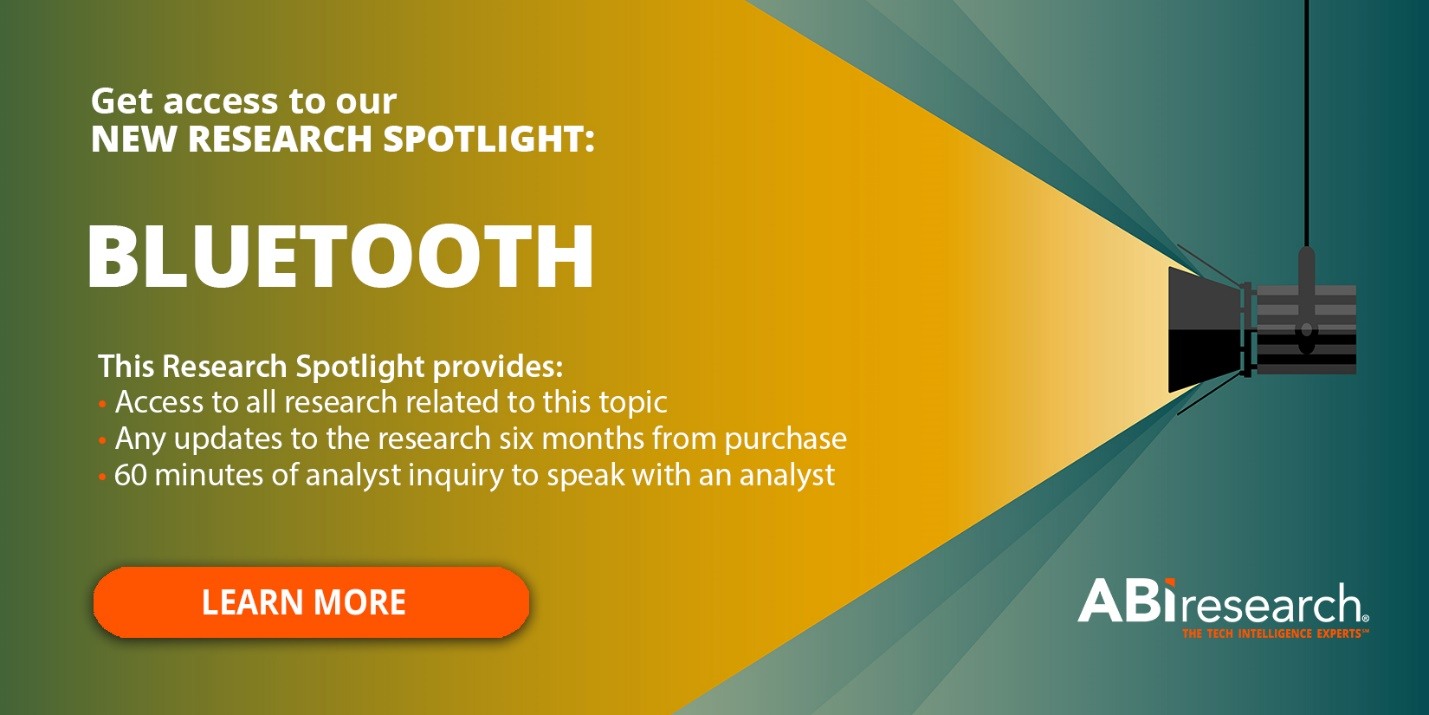One key challenge retailers face is inaccurate pricing on product shelf labels. If one of your customers expects a product to cost US$4.99, but learns upon checkout that the actual price is US$9.99, how do you think they will respond? Some customers might shrug it off and not think twice about it; however, most will be left with a bad taste in their mouth and perhaps lose their brand loyalty. Retailers are increasingly adopting Electronic Shelf Labels (ESLs), replacing traditional paper labels to prevent this scenario. While ESLs have existed for years, the installed base is low. Newer connectivity technologies are unlocking far more value for retailers beyond dynamic pricing, spurring greater demand for ESLs in a post-COVID-19 world.
What Is an Electronic Shelf Label?
Electronic shelf labels are battery-powered displays that exhibit key retail information, such as pricing, special offers and promotions, inventory status, and product details. ESL devices work by sending and receiving information in accordance with the store network through Bluetooth or other wireless connectivity technologies. This allows the retail shelf labels to be updated in real time, eliminating the requirement for an employee to manually print new paper labels and change the product information on the shelf.
Chart 1: Electronic Shelf Label Shipments
World Markets: 2021 to 2028
(Source: ABI Research)

How Electronic Shelf Labels Have Gotten Smarter
The future of smart retail will include broader Internet of Things (IoT) applications requiring various wireless technologies. Electronic shelf labels are a key piece to this future vision, but legacy ESL solutions cannot deliver the increasingly complex outcomes retailers need. Whereas the first generation of ESLs solely focused on basic pricing updates, newer generations support additional retail use cases.
Electronic shelf labels have evolved significantly, now supporting anything from multi-color Light-Emitting Diode (LED) lighting to mobile payment facilitation. For example, Near Field Communication (NFC)/Quick Response (QR) codes let customers and employees learn more about a product simply by placing their mobile devices near the shelf label. As another example, some Bluetooth-supported ESL solutions (e.g., Displaydata) support proximity-based marketing offers based on a customer’s preferences and location in the store. Then there are Kroger’s EDGE ESLs, which can read the grocery list on a customer’s mobile device and light up the product shelf label for easy picking. These technological advancements in ESLs result in a more satisfying customer experience, boosted brand loyalty, and increased productivity.
Other notable ESL upgrades shaping retail include:
- More shelf label pages supported (7+ pages)
- More LED colors specific to each use case
- Multiple buttons per device for back end operations
- Greater variety in ESL form size
- Higher resolution displays
- Faster update speeds
- Better resistance to harsh environmental conditions
- Longer battery life (up to 10 to 15 years)
Figure 1: Evolution of the Electronic Shelf Label Market
(Source: ABI Research)

Retail Benefits of Electronic Shelf Labels
The benefits of modern electronic shelf labels are wide-ranging, and both retailers and customers are the recipients of such benefits. ESLs automate often time-consuming tasks for retailers, while ensuring improved pricing accuracy and shopping convenience for customers. The list below goes into more detail on all the benefits of ESLs.
- Real-Time Automated Pricing: ESLs allow retailers to update prices on the fly, which is crucial in times of high inflation or during seasonal/holiday periods. By reflecting product prices more swiftly and accurately, retailers can improve the customer experience—and thus, customer “stickiness.” Retailers can eliminate those 5% to 10% of price errors associated with paper shelf labels.
- Sustainability: Due to their digital nature, electronic shelf labels reduce the need for paper and printing materials. Moreover, ESLs can display information about recycling, carbon footprint, energy rating, source materials, and other information that promotes transparency into supply chain sustainability.
- Enhanced Customer Experiences: Modern ESLs combined with Near Field Communication (NFC) and Quick Response (QR) codes can go beyond displaying simple pricing information; they can present to customers nutritional/allergen information, stock updates, product reviews, different currency exchange rates, etc. Moreover, some Bluetooth-enabled ESLs will send tailored proximity-based promotional offers and price checks with competitors straight to customers’ mobile devices.
- Self-Checkout: When equipped with NFC tags, an electronic shelf label can facilitate self-checkout for customers by holding their mobile device near the label. This provides convenience for customers, while alleviating staffing complexities for retailers during busy periods.
- Data Analytics: ESLs that leverage Bluetooth or sensors can also provide rich, data-centric insight into in-store traffic trends. This helps retailers choose the best product/floor layouts to maximize sales.
- Optimized Inventory Management: The use of ESLs results in improved inventory management because they accurately track inventory levels in real time, thereby allowing retailers to replenish products quickly. ESLs can also display online availability to customers if a product is out of stock. In that case, the shelf label will share a link (NFC or QR code) to the store’s website to complete an order or offer a discount that can be applied upon the product being back in stock.
- Faster Order Picking and Replenishment: E-commerce is growing every year, making streamlined online order picking essential to keeping up with demand and meeting delivery windows. Electronic shelf labels help here, as the displays will light up, allowing store employees to pinpoint where the right products are on shelves quickly. The same principle applies to use cases where a product must be returned to the shelf.
- Maximize Staff Resources and Job Satisfaction: ESLs automate monotonous tasks that take away employees’ time toward bigger business priorities. When pricing labels can be automated, store workers can spend more time on things like communicating with customers and improving customer service. Doing more rewarding tasks goes hand-in-hand with higher levels of job satisfaction, thereby reducing staffing turnover.
- Regulatory Support: Some countries such as Germany introduce new regulations stipulating that both the basic price and item price are listed on shelf labels. Other countries are supporting or adopting new currencies as well. These regulations mean that retailers must update their product shelf labels nationwide, which can be streamlined using ESLs.
As these benefits highlight, implementing electronic shelf labels in retail settings is a win-win solution. These technologies automate operations for retailers and make for a better, even more personalized shopping experience for consumers.
Assessing the Electronic Shelf Label Market
Most retailers are still in the Proof of Concept (PoC) stage of implementing electronic shelf labels, only conducting pilots. Given the novelty of newer ESL solutions, retailers are hesitant about committing to a single vendor. Instead, retailers such as Carrefour are partnering with multiple ESL vendors to avoid a long-term lock-in with a vendor.
The electronic shelf label market has been mostly centered around Europe, where retailers typically have higher labor costs. A notable case study includes Netherlands-based supermarket chain Jumbo partnering with retail solutions provider Hanshow to digitally transform more than 250 of its stores. And there are plans to install more than 11 million electronic shelf labels in all 700 store locations.
A few European vendors have dominated the market, making growth outside the region less than stellar, thus far. Nevertheless, ESL deployments have surged in the last 24 months, with some vendors reporting record sales numbers. Our research findings indicate that North America is catching up to Europe, with Canada being Pricer’s largest regional market in 2021, and retailers in the United States increasing adoption. However, the Asia-Pacific market will increase its adoption of ESLs at the fastest rate. This results from new Chinese entrants introducing low-cost solutions for regional retailers, and large-scale ESL deployments in China and Japan.
Going forward, retailers should choose ESL solutions that can verifiably help achieve Key Performance Indicators (KPIs), support multiple use cases, are easy to deploy, and meet smart retail standards.
This content was part of ABI Research’s Bluetooth Electronic Shelf Labels: Retail Market Opportunities and Challenges product. You may learn more about the newest Bluetooth technologies by purchasing our Bluetooth Research Spotlight.

